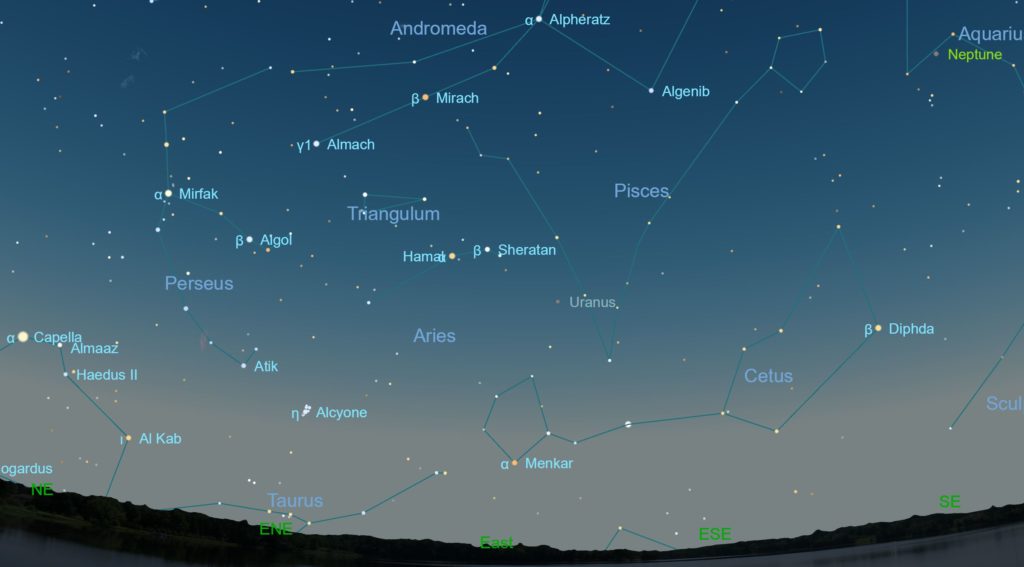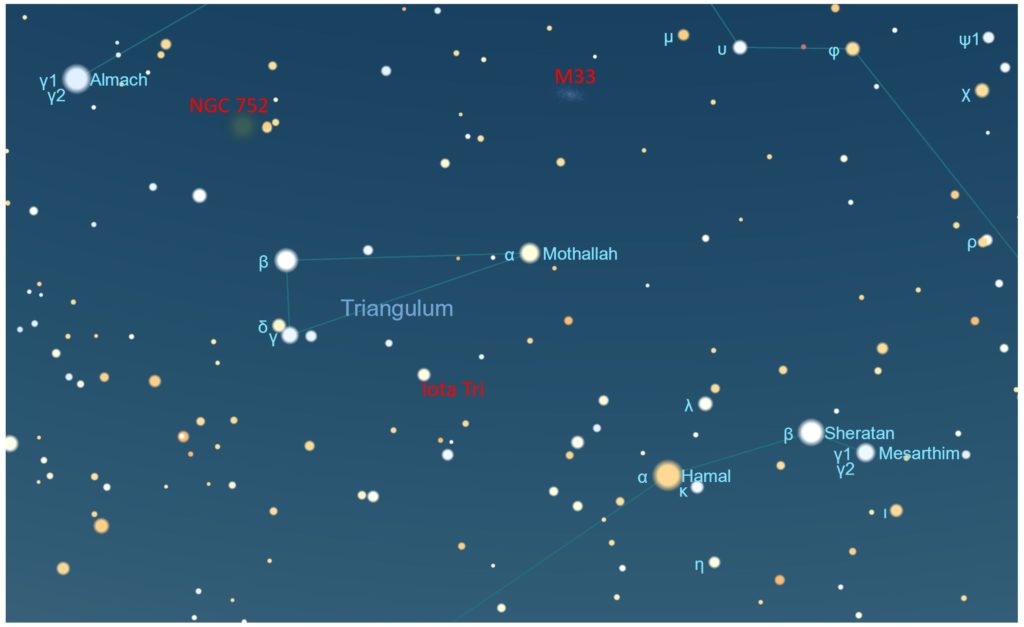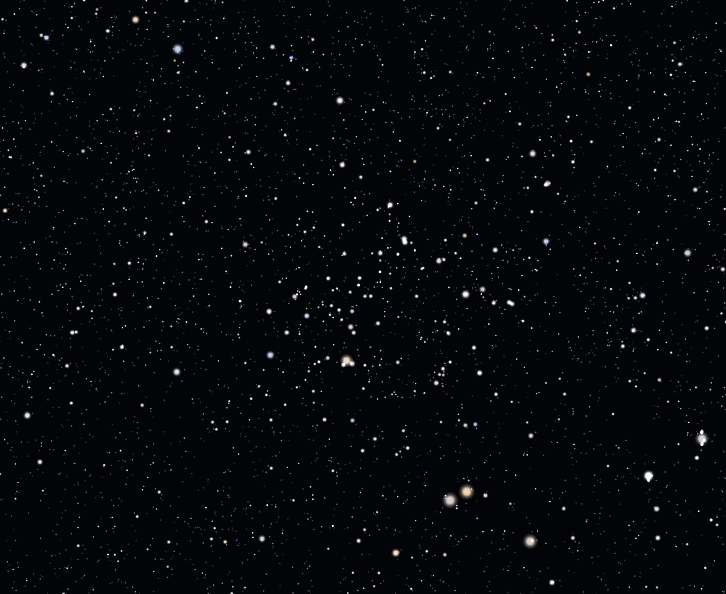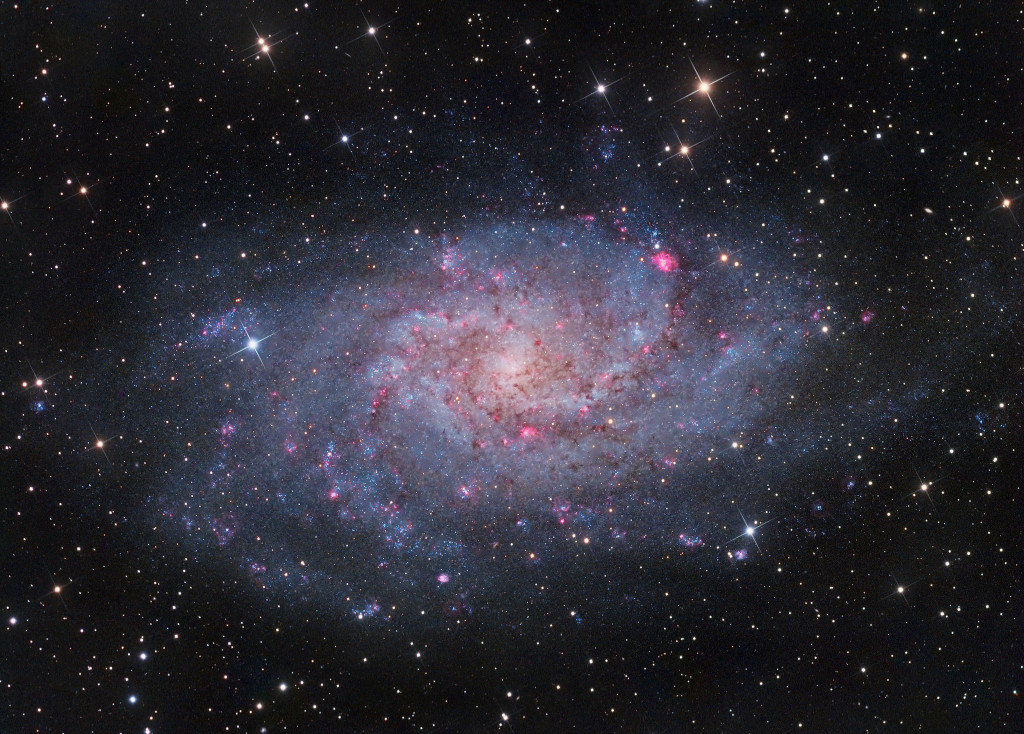
Take any three stars and they’ll form some kind of triangle. But there is only one constellation Triangulum. It’s a small but ancient star group surrounded by the larger constellations Andromeda to the north and west, Pisces to the southwest, Aries to the south, and Perseus to the northeast. While modest, Triangulum hosts many fine sights for stargazers on a northern autumn (or southern spring) evening. Look for it about 10º due south of the star Almaak (γ Andromedae) and just northeast of Aries.
The name of the constellation comes, unsurprisingly, from the Latin for “triangle”. The stars β (beta) and γ (gamma) Trianguli, magnitudes 3.0 and 4.0 respectively, form the base of the little triangle, while α (alpha) Trianguli, at the apex, is a star of magnitude 3.4. The shape of this little constellation caused ancient Greek stargazers to link it to the Nile Delta, while Roman stargazers linked the constellation to the island of Trinacria (now called Sicily) which has a somewhat triangular shape.
Beta Trianguli is a spectroscopic binary star about 127 light years away. Alpha (α) Trianguli, also called Mothallah, which is Arabic for triangle, also has a close companion detectable only with careful spectroscopic measurement. Gamma Trianguli is a more rewarding sight for backyard observers. This whitish-color main sequence star makes an excellent sight in binoculars with its apparent companions δ (delta) Trianguli and 7 Trianguli. The stars are not physically associated, but they sure look pretty together.

For observers with a telescope, iota (ι) Trianguli is a fine double star with a yellow and blue component separated by a little less than 4″ (arc-seconds). It makes for good viewing at 100x or more in nearly any scope. Each component is itself a tightly-spaced and unresolvable double star, which means ι Tri is a four-star system. The pair is cataloged in some star maps as 6 Trianguli.

And there is NGC 752, a lovely star cluster often overlooked for more famous deep sky sights in this part of sky. The cluster is easily visible to the unaided eye in clear and dark sky a little less than halfway between the 3rd-magnitude beta (β) Trianguli and 4th-magnitude upsilon (υ) Andromedae.
NGC 752 is a somewhat sprawling cluster, ideal for 3-inch to 4-inch telescopes at low magnification. Use an eyepiece with a wide field of view, at least 1º. At 50x, the cluster reveals 70-90 faint stars spread over 40′ (arc-minutes). Many stars within the cluster are yellow and orange, which implies the bright blue and white stars have long ago run out of fuel. And indeed NGC 752 is more than 2 billion years old, a very great age for an open star cluster. The cluster lacks a well-defined central region or outer boundaries. This is another common feature of older clusters, as many of its constituent stars have been stripped away by gravitational interaction with other stars and molecular clouds.
Near the center of NGC 752, look for an orange 7th magnitude star in a tight triangle with two fainter stars. The orange star is likely not related to the cluster. Less than half a degree southwest of the cluster, look for a pair of 6th-magnitude stars with orange and gold hues.
The most famous sight in Triangulum is the small spiral galaxy Messier 33, the second-closest spiral galaxy after the much larger and brighter Andromeda Galaxy, Messier 31. Often called the Triangulum Galaxy, in photographs M33 is lovely as a lotus-blossom and rich with new blue stars and pink nebulae along its spiral arms.
It is a challenging object for visual observers, however, but still worthy of careful inspection in a small telescope in dark skies. M33 is listed as magnitude 5.7, so you may think it’s bright enough to see easily in a telescope. It is not. Its brightness is spread over an area four times larger than the full moon, so M33 has a low surface brightness and is notoriously hard to find in light-polluted or moonlit sky. Some observers use M33 as a sky test: if you can see M33 with your naked eye, you have extremely dark and clear sky (and pretty good vision, too).

The galaxy is 2.7 million light years away. That makes it is the farthest object visible without optical aid for most observers.
To find M33, sweep the region about 4.5º west-northwest of 3rd-magnitude alpha (α) Trianglulum. Use low power and a wide field of view. Moving your scope or tapping on its side may help you see this faint galaxy. Stay with low magnification to take it all in. You may see some structure and mottling in the spiral arms with a 4-inch to 6-inch telescope. Higher magnification with an 8-inch to 12-inch telescope seems to dim the view somewhat, but often brings out more structure in the arms, especially the tiny knots of nebulosity of star-forming regions.
The spiral arms of M33 are festooned with the pink glow of star-forming nebulae. The largest such region, NGC 604, is visible in a 6-inch or larger telescope under good conditions. NGC 604 is visible as a tiny star-like region about 12′ northeast of the nucleus of M33. A 10th-magnitude foreground star is just 1′ to the southeast of the nebula. The star and the nebula look at first like a double star, but you will notice one of the stars will not come to a focus… that’s the nebula. Try a nebula filter to improve the contrast of this extremely distant region of ionized gas and newly formed stars.
NGC 604 is visible with a small telescope from such a great distance because it is amazingly large – about 100x the size of the Orion Nebula – and it is illuminated by more than 200 massive stars at its center. It’s not an easy object to see, but it’s well worth the effort.